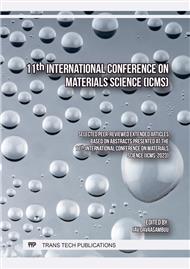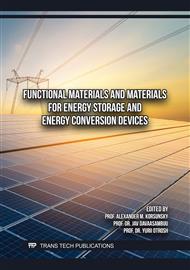[1]
W. Zhang, B. Zhao, Z. He et al. High-efficiency ITO-free organic solar cells Using Highly Conductive PEDOT:PSS/Surfactant Bilayer Transparent Anodes[J]. Energy Environ. Sci., 2013, 6: 1956-1964.
DOI: 10.1039/c3ee41077c
Google Scholar
[2]
L. Hu, M. Li, K. Yang, PEDOT:PSS Monolayers to Enhance Hole Extraction and Stability of Perovskite Solar Cells[J]. Journal of Materials Chemistry A,2018,6(34):16583-16589.
DOI: 10.1039/c8ta05234d
Google Scholar
[3]
S. Zhang, Z. Yu, P. Li et al. Poly(3,4-ethylenedioxythiophene): Polystyrene Sulfonate Films with Low Conductivity and Low Acidity Through a Treatment of Their Solutions with Probe Ultrasonication and Their Application as Hole Transport Layer in organic solar cells and Perovskite Solar Cells[J]. Organic Electronics, 2016, 32: 149-156.
DOI: 10.1016/j.orgel.2016.02.024
Google Scholar
[4]
M. de Kok, M. Bueche, S. I. E. Vulto et al. Modification of PEDOT:PSS as Hole Injection Layer in Polymer LEDs. Phys. Stat. Sol, 2004, 6, 201.
Google Scholar
[5]
X. Huang, K. Wang, C. Yi et al. Efficient Perovskite Hybrid Solar Cells by Highly Electrical Conductive PEDOT:PSS Hole Transport Layer[J]. Adv. Energy Mater, 2016, 6, 1501773.
DOI: 10.1002/aenm.201501773
Google Scholar
[6]
Z. Hu, J. Zhang, Z. Hao et al. Influence of Doped PEDOT:PSS on the Performance of Organic Solar Cells [J]. Solar Energy Materials & Solar Cells, 2011, 95: 2763-2767.
DOI: 10.1016/j.solmat.2011.04.040
Google Scholar
[7]
J. Thomas, L. Zhao, D. Gillivray et al. High-efficiency Hybrid Solar Cells by Nanostructural Modification in PEDOT:PSS with Co-solvent Addition[J]. J. Mater. Chem. A, 2014, 2, 2383-2389.
DOI: 10.1039/c3ta14590e
Google Scholar
[8]
K. Zhang, Z. Hu, C. Duan et al. The Effect of Methanol Treatment on the Performance of Organic Solar Cells [J]. Nanotechnology, 2013, 24, 484003.
Google Scholar
[9]
B. Fan, X. Mei et al. Significant Conductivity Enhancement of Conductive Poly(3,4-ethylene dioxythiophene): Poly(styrene sulfonate) Films by Adding Anionic Surfactants into Polymer Solution[J]. Macromolecules, 2008, 41: 5971-5973.
DOI: 10.1021/ma8012459
Google Scholar
[10]
T Nagata,S Oh,T Chikyow et al. Effect of UV-ozone treatment on electrical properties of PEDOT:PSS film[J]. Organic Electronics, 2011, 12, 279-284.
DOI: 10.1016/j.orgel.2010.11.009
Google Scholar
[11]
Q. An, F. Zhang, W. Gao et al. High-efficiency and Air Stable Fullerene-free Ternary Organic Solar Cells[J]. Nano Energy, 2018, 45: 177–183.
DOI: 10.1016/j.nanoen.2017.12.050
Google Scholar



